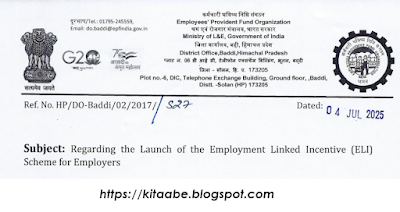Free E-Books & Govt.Docs
Download 100% Free E-Books and Govt. Documents, Circulars, Acts etc..
Himachal Pradesh Minimum Wages April 2025
Whereas, the Governor, Himachal Pradesh is of the opinion that the minimum rates of wages in respect of unskilled category of workers in the Scheduled employment of ''Agriculture'' may be revised with effect from 01-04-2025
Store and Protect your Data in the Cloud - Free e-book
If your small or medium business (SMB) struggles with missing or incomplete files, version control, backups, and escalating storage costs, this eBook is for you. Take a step-by-step approach to understand the costs of cloud vs. on-premises storage, assess your SMB’s readiness, and learn how Amazon Web Services is best equipped to help you store and protect data as you scale.
Download
Download
Oracle Magazine January/February 2018
Welcome to the January/February 2018 issue of Oracle Magazine, focused on open stack and open source development as well as the present and future of artificial intelligence.
This issue's cover story, The Future Is Open, looks at Oracle's open technology stack and strategies for using—and contributing to—open source software. Learn how Oracle's open stack and open source commitment to cloud-native development is fueling innovation.
This issue's It's Pervasive: AI is Everywhere story explores just how strategic artificial intelligence has already become and looks ahead to an even brighter future. The story discusses multiple Oracle Cloud services that currently leverage AI to support and improve business processes.
For database developers, Dan McGhan's Using Async Functions is Part 4 in a four-part series on asynchronous Node.js development. Steven Feuerstein's Just Say No, Unless You Can't explores how to prevent SQL injection attacks by knowing when not to use dynamic SQL. In Get Your Rest; POST Your SQL Jeff Smith demonstrates how to use the new REST-enabled SQL in the latest release of Oracle REST Data Services.
Read the new issue now or download:
मासिक पत्रिका : वैदिक उपासना, अप्रैल 2017
आपको बताते हुए आनन्द हो रहा है कि आजके इस शुभ दिवससे राष्ट्र एवं धर्मके उत्थान निमित्त समर्पित, हमारी निःशुल्क, ऑनलाइन धार्मिक मासिक पत्रिका 'सोऽहं', की कागदी प्रति 'वैदिक उपासना'के नामसे प्रकाशित हो रही है और यह मासिक पत्रिका अब अपने नूतन नाम 'वैदिक उपासना'के नामसे प्रेषित की जायेगी | आप इसकी कागदी प्रति मंगवाने हेतु इसके वार्षिक या पञ्च वार्षिक सदस्य बनकर एवं अन्योंको इसके वार्षिक या पञ्च वार्षिक सदस्य बनाकर, हमारे इस कार्यमें अपना सहयोग दे सकते हैं | साथ ही आप राष्ट्र एवं धर्मसे सम्बन्धित अपने लेख भी हमें भेज सकते हैं एवं इस पत्रिकाके लिए आपका सुझाव भी भेज सकते हैं | वार्षिक सदस्य बनने या बनाने हेतु आप हमसे संगणकीय संपत्र (इ-मेल)या निम्नलिखित चलभाषपर संपर्क कर सकते हैं |
महेंद्र शर्मा
वैदिक उपासना पीठ
9717492325
Subscribe to:
Posts (Atom)
Popular Documents
-
Just before dawn one winter's morning, a hijacked jetliner explodes above the English Channel. Through the falling debris, two figures, ...
-
इस्लाम में धर्मांतरण के मुख्य साधन थे म्रत्यु भय या परिवार को गुलाम बनाये जाने का भय, आर्थिक लोभ ( पारितोषिक, पेन्शन, लूट का माल ) धर्म...
-
The Himachal Pradesh Tenancy and Land Reforms Act, 1972 Full Scanned Copy. Download
-
ज्योतिष्य स्वयं शिक्षक - फल ज्योतिष - पी. एन. ओक (हिंदी में ) Download
-
रंगीला रसूल १९२० के दशक में प्रकाशित पुस्तक है जो लाहौर के राजपाल एण्ड सन्स ने प्रकाशित की थी। इसके लेखक 'चामुपति एम ए' या किश...
-
Download Full Free The Code of Criminal Procedure, 1973 Bare Act. Download
-
The pre-eminent political and spiritual leader of India's independence movement, pioneer of non-violent resistance to tyranny thro...
-
Minimum Wages Notification of Himachal Pradesh 19th May 2012. Download PDF File.












